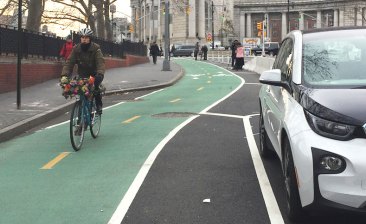Trottenberg: DOT Will Soon Propose Amsterdam Avenue Bike Lane
DOT will release a long-awaited proposal for a bike lane and other traffic calming measures on Amsterdam Avenue on the Upper West Side this September or October, Transportation Commissioner Polly Trottenberg said on WNYC’s Brian Lehrer Show this morning.

The announcement comes after years of requests from local advocates and Manhattan Community Board 7 for a northbound pair to the southbound protected bike lane on Columbus Avenue. Council members Helen Rosenthal and Mark Levine, who represent the area, have also backed a protected bike lane on Amsterdam, which was recently repaved. Citi Bike will expand to the Upper West Side this fall.
“Amsterdam Avenue is challenging… Just the way the traffic moves and the configuration of the roadway do make it a more challenging road to redesign [than Columbus],” Trottenberg said. “But we’re going to come up with some plans and we’re going to lay them out for the community board and for everyone who’s interested.”
The wide-ranging interview also discussed a proposal from Assembly Member Aravella Simotas for a car-free Shore Boulevard in Astoria Park (“We are taking a look at it,” Trottenberg said) and the redesign of Queens Boulevard, which she called one of DOT’s “marquee” projects. Noting the new bike lanes on Queens Boulevard, Lehrer said callers are often “more afraid of the bicycles, because they seem to go every which way, than they are of the cars.”
Much of the interview was driven by Lehrer’s focus on congestion and bikes.
“Is there an upside to congestion?” he asked Trottenberg. “Like, is traffic congestion good for Vision Zero, because you want cars to go slower in general?”
“They’re really two separate issues, and I understand why people put them together,” Trottenberg said, before explaining the difference between making sure free-flowing traffic moves at a safe speed and combatting gridlock in the Central Business District, which is attracting fewer cars each day even as congestion has worsened.
Cruising by Uber drivers and other growing for-hire services is a likely cause of the additional congestion, Trottenberg said, and she acknowledged other factors, such as deliveries. The city will study CBD congestion after backing away from legislation to cap the number of cars operated by Uber.
“How about the bikes as a factor?” Lehrer asked.
“[DOT] has tried to be very careful and thoughtful about where we put in bike lanes, and doing it in conjunction with a lot of other smart re-engineering of the streets to keep traffic flowing,” Trottenberg said.
The conversation became more productive when Lehrer turned to the MTA, where Trottenberg serves as a board member. The state authority faces a large gap in its capital program, yet Governor Andrew Cuomo and the legislature have yet to propose a sustainable funding solution. Cuomo says the multi-billion dollar commitment will come from the existing state and city budgets.
“We’re open to working with the state and our legislators up in Albany,” Trottenberg said. “The mayor put Move NY and other things on the table, but I think he also made the point that one of the challenges we face at the city level is we don’t have that much of an ability to generate revenue ourselves. So even if the city is quote-unquote contributing more, that solution is also going to involve Albany.”
Trottenberg said that if the city contributes more, it will also want a greater say over the direction of the MTA capital program. “I mean, look, East Side Access is a project which I think is really one designed to benefit the riders of the Long Island Rail Road,” she said. The over-budget and delayed project, however, is too far along to cancel, she said. “We’ve got to complete it.”
The city will also be likely on the hook for future expansions of the Second Avenue subway, Trottenberg revealed. “The MTA has now asked the city to fully cover the non-federal share of the next phase of the Second Avenue subway,” she said. “But the city, we also have some priorities,” including the Utica Avenue subway extension and the expansion of CityTicket for Metro-North and LIRR customers in the city. “There’s also some things we’d like to put on the table, as well.”
